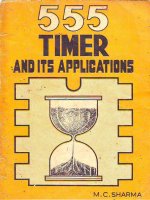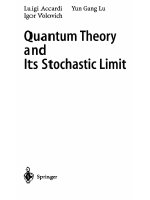Game theory and its applications
Bạn đang xem bản rút gọn của tài liệu. Xem và tải ngay bản đầy đủ của tài liệu tại đây (13.55 MB, 245 trang )
Akio Matsumoto and Ferenc Szidarovszky
Game Theory and Its Applications
1st ed. 2016
Akio Matsumoto
Department of Economic, Chuo University, Hachioji, Tokyo, Japan
Ferenc Szidarovszky
Department of Applied Mathematics, University of Pécs, Pécs, Hungary
ISBN 978-4-431-54785-3 e-ISBN 978-4-431-54786-0
DOI 10.1007/978-4-431-54786-0
Springer Tokyo Heidelberg New York Dordrecht London
Library of Congress Control Number: 2015947124
© Springer Japan 2016
This work is subject to copyright. All rights are reserved by the Publisher, whether the whole or part
of the material is concerned, specifically the rights of translation, reprinting, reuse of illustrations,
recitation, broadcasting, reproduction on microfilms or in any other physical way, and transmission
or information storage and retrieval, electronic adaptation, computer software, or by similar or
dissimilar methodology now known or hereafter developed.
The use of general descriptive names, registered names, trademarks, service marks, etc. in this
publication does not imply, even in the absence of a specific statement, that such names are exempt
from the relevant protective laws and regulations and therefore free for general use.
The publisher, the authors and the editors are safe to assume that the advice and information in this
book are believed to be true and accurate at the date of publication. Neither the publisher nor the
authors or the editors give a warranty, express or implied, with respect to the material contained
herein or for any errors or omissions that may have been made.
Printed on acid-free paper
Springer Japan KK is part of Springer Science+Business Media (www.springer.com)
Preface
The authors of this book had several decades of research in different areas of game theory until the
mid 1990s, when they met in a conference in Odense, Denmark. Since then they work together on
oligopolies and different dynamic economic systems, and meet at least once every year in Tokyo and
either in Tucson, Arizona or in Pécs, Hungary.
This book has two origins. First it is based on game theory short courses presented in several
countries including Japan, Hungary, China, and Taiwan among others. The second author introduced
and taught for several years a one-semester graduate-level game theory course at the University of
Arizona for students in engineering and management. The class notes of that course is the second
origin of this book. The objective of this book is to introduce the readers into the main concepts,
methods, and applications of game theory, the subject, which has continuously increasing importance
in applications in many fields of quantitative sciences including economics, social science,
engineering, biology etc. The wide variety of applications are illustrated with the particular examples
introduced in the second and third chapters as well as with the case studies of the last chapter.
We strongly recommend this book to undergraduate and graduate students, researchers, and
practitioners in all fields of quantitative science where decision problems might arise involving more
than one decision makers, stake holders, or interest groups. As we will see later in the different
chapters, the most appropriate solution concept and the corresponding solution methodology for any
problem is a function of the behavior of the decision makers and their interrelationships, and the
available information. So before applying any method from this book, these conditions have to be
examined. Then the most appropriate method has to be selected and applied to get the solution, which
has to be then interpreted and applied in practice.
We sincerely hope that this book will help the readers to understand the main concepts and
methodology of game theory and it will help to select the most appropriate model, solution concept
and method, and to use the obtained result in applying it in their practical problems.
The authors are thankful to the Department of Economics of Chuo University, Tokyo as well as the
Systems and Industrial Engineering Department of the University of Arizona, Tucson for their
hospitality during the joint works of the authors. The more recent support of the Applied Mathematics
Department of the University of Pécs, Hungary is also appreciated.
In addition, the authors wish to express their special thanks to Dr. Taisuke Matsubae for his
assistance in preparing the manuscript and the final edited version of this book.
Contents
1 Introduction
Part I Noncooperative Games
2 Discrete Static Games
2.1 Examples of Two-Person Finite Games
2.2 General Description of Two-Person Finite Games
2.3
-person Finite Games
3 Continuous Static Games
3.1 Examples of Two-Person Continuous Games
3.2 Examples of
-Person Continuous Games
4 Relation to Other Mathematical Problems
4.1 Nonlinear Optimization
4.2 Fixed Point Problems
5 Existence of Equilibria
5.1 General Existence Conditions
5.2 Bimatrix and Matrix Games
5.3 Mixed Extensions of N-person Finite Games
5.4 Multiproduct Oligopolies
6 Computation of Equilibria
6.1 Application of the Kuhn–Tucker Conditions
6.2 Reduction to an Optimization Problem
6.3 Solution of Bimatrix Games
6.4 Solution of Matrix Games
6.5 Solution of Oligopolies
7 Special Matrix Games
7.1 Matrix with Identical Elements
7.2 The Case of Diagonal Matrix
7.3 Symmetric Matrix Games
7.4 Relation Between Matrix Games and Linear Programming
7.5 Method of Fictitious Play
7.6 Method of von Neumann
8 Uniqueness of Equilibria
9 Repeated and Dynamic Games
9.1 Leader-Follower Games
9.2 Dynamic Games with Simultaneous Moves
9.3 Dynamic Games with Sequential Moves
9.4 Extensive Forms of Dynamic Games
9.5 Subgames and Subgame-Perfect Nash Equilibria
10 Games Under Uncertainty
10.1 Static Bayesian Games
10.2 Dynamic Bayesian Games
Part II Cooperative Games
11 Solutions Based on Characteristic Functions
11.1 The Core
11.2 Stable Sets
11.3 The Nucleolus
11.4 The Shapley Values
11.5 The Kernel and the Bargaining Set
12 Conflict Resolution
12.1 The Nash Bargaining Solution
12.2 Alternative Solution Concepts
12.3
-person Conflicts
13 Multiobjective Optimization
13.1 Lexicographic Method
13.2 The
-constraint Method
13.3 The Weighting Method
13.4 Distance-Based Methods
13.5 Direction-Based Methods
14 Social Choice
14.1 Methods with Symmetric Players
14.2 Methods with Powers of Players
15 Case Studies and Applications
15.1 A Salesman’s Dilemma
15.2 Oligopoly in Water Management
15.3 A Forestry Management Problem
15.4 International Fishing
15.5 A Water Distribution Problem
15.6 Control in Oligopolies
15.7 Effect of Information Lag in Oligopoly
Appendix A: Vector and Matrix Norms
Appendix B: Convexity, Concavity
Appendix C: Optimum Conditions
Appendix D: Fixed Point Theorems
Appendix E: Monotonic Mappings
Appendix F: Duality in Linear Programming
Appendix G: Multiobjective Optimization
Appendix H: Stability and Controllability
References
Index
List of Figures
Figure 2.1 Equilibria in Example 2.8
Figure 2.2 Structure of the city
Figure 3.1 Best responses in Example 3.1
Figure 3.2 Best responses in Example 3.2
Figure 3.3 Best responses in Case 1
Figure 3.4 Best responses in Case 4
Figure 3.5 Best responses in Case 5
Figure 3.6 Best responses in Case 6
Figure 3.7 Payoff function of player 1 in Example 3.4
Figure 3.8 Illustration of
Figure 3.9 Best responses in Example 3.4
Figure 3.10 Payoff function of player 1 in Example 3.5
Figure 3.11 Best responses in Example 3.5
Figure 3.12 Payoff of player 1 in Example 3.6
Figure 3.13 Best responses in Example 3.7
Figure 3.14 Payoff
in Example 3.8
Figure 3.15 Best responses in Example 3.8
Figure 3.16 Payoff
in Example 3.9
Figure 3.17 Best responses in Example 3.9
Figure 3.18 Best responses in Example 3.10
Figure 3.19 Payoff
in Example 3.11
Figure 3.20 Payoff
in Example 3.11
Figure 3.21 Best responses in Example 3.11
Figure 3.22 Payoff
in Example 3.12
Figure 3.23 Payoff
in Example 3.12
Figure 3.24 Best responses in Example 3.12
Figure 5.1 Payoff functions of Example 5.4
Figure 5.2 Best responses in Example 5.5
Figure 5.3 Best responses in Example 5.6
Figure 5.4 Best responses in Example 5.7
Figure 6.1 Best responses in Example 6.4
Figure 6.2 Feasible sets in problems (6.15)
Figure 6.3 Price function in Example 6.7
Figure 8.1 Best responses in Example 8.1
Figure 9.1 Illustration of the bargaining set in Example 9.6
Figure 9.2 A finite tree game with three players
Figure 9.3 Illustration of the backward induction
Figure 9.4 Game tree of Example 9.9
Figure 9.5 Extensive form of Example 9.11
Figure 9.6 Modified graph of Example 9.3
Figure 9.7 Extensive form in the prisoner’s dilemma game
Figure 10.1 Extensive form of the battle of sexes game
Figure 10.2 Extensive form of a signaling game
Figure 12.1 Illustration of a conflict
Figure 12.2 A simple geometric fact
Figure 12.3 Steps of the proof of Theorem 12.1
Figure 12.4 Illustration of Axiom 4
Figure 12.5 Other illustration of Axiom 4
Figure 12.6 Illustration of the Kalai–Smorodinsky solution
Figure 12.7 Illustration of the area monotonic solution
Figure 13.1 Decision space in Example 13.1
Figure 13.2 Payoff space in Example 13.1
Figure 13.3 Illustration of Example 13.4
Figure 13.4 Illustration of Example 13.8
Figure 13.5 Illustration of Example 13.9
Figure 13.6 Non-Pareto optimal solution
Figure 14.1 Preference graph
Figure 14.2 Preference graph with weighted players
Figure 14.3 Reduced preference graph
Figure 15.1 Different cases in equilibrium analysis
Figure B.1 Convex function
Figure D.1 Illustration of Brouwer’s fixed point theorem
Figure G.1 Weakly and strongly nondominated solutions
List of Tables
Table 2.1 Payoff table of Example 2.1
Table 2.2 Payoff table of Example 2.2
Table 2.3 Payoff table of Example 2.3
Table 2.4 Payoff table of Example 2.4
Table 2.5 Payoff table of Example 2.5
Table 2.6 Payoff table of Example 2.6
Table 2.7 Payoff table of Example 2.7
Table 2.8 Payoff table of Example 2.8
Table 2.9 Payoff table of Example 2.9
Table 2.10 Payoff tables of two-person finite games
Table 2.11 Payoff table of Example 2.11
Table 9.1 Payoff table of Example 9.8
Table 9.2 Payoff matrix of game of Fig. 9.5
Table 10.1 Modified payoff matrix of Example 2.1
Table 10.2 Payoff matrix of the Type II game
Table 10.3 Occurance probability values
Table 10.4 Payoff matrices of player 1 in Example 10.3
Table 10.5 Final payoff matrix of player 1 in Example 10.3
Table 14.1 Data of Example 14.1
Table 14.2 Reduced data set by eliminating alternative 1
Table 14.3 Second reduced table by eliminating alternative 4
Table 14.4 Reduced data set by eliminating alternative 3
Table 14.5 Second reduced table by eliminating alternative 4
Table 14.6 Reduced data set by eliminating alternative 4
Table 14.7 Second reduced table by eliminating alternative 1
Table 14.8 Data of Example 14.2
Table 14.9 Reduced table by eliminating alternative 1
Table 14.10 Second reduced table by eliminating alternative 4
Table 15.1 Payoff matrix of player 1
Table 15.2 Rankings of the alternatives
Table 15.3 Reduced table for Hare system
Table 15.4 Further reduced table for Hare system
Table 15.5 Reduced table in pairwise comparisons
Table 15.6 Model data
Table 15.7 Nash equilibrium results
Table 15.8 Weighting method results
© Springer Japan 2016
Akio Matsumoto and Ferenc Szidarovszky, Game Theory and Its Applications, DOI 10.1007/978-4-431-54786-0_1
1. Introduction
Akio Matsumoto1 and Ferenc Szidarovszky2
(1) Department of Economic, Chuo University, Hachioji, Tokyo, Japan
(2) Department of Applied Mathematics, University of Pécs, Pécs, Hungary
Akio Matsumoto (Corresponding author)
Email:
Ferenc Szidarovszky
Email:
In our private life and also in our professional life we have to make decisions repeatedly. Some
decisions might have very small consequences, and there are decisions and the consequences of
which might have significant affects in our life. As such examples we can consider the choice of an
item in our lunch and accepting or rejecting a job offer. Decision science is dealing with all kinds of
decision problems, concepts, and solution methodologies.
In formulating a mathematical model of a decision problem, there are two conflicting tendencies.
In one hand we would like to include as many variables, constraints, and possible consequences as
possible in order to get close to reality. However on the other hand, we would like to solve the
models, so they must not be too complicated. In creating a decision making model, we have to identify
the person or persons who are in charge, that is, who is or are responsible to decide. There are two
major possibilities: one or more decision makers are present. In order to decide in any choice, the set
of all possible decision alternatives have to be made clear to the decision makers. If this set is finite
or countable, then the decision problem is called discrete, and if it is a connected set (like an
interval), then the problem is considered to be continuous. In the first case, the alternatives are simply
listed in an order, and in the second case the alternatives are characterized by decision variables and
the set of the alternatives is defined by certain inequalities and equations containing the decision
variables. We usually make decisions to gain or avoid something. The goodness of any decision can
be measured by the different levels of attributes such as received profit, economic loss, level of
pollution, and water supply. We can usually attach a utility value to each possible level of the
attributes which represents the goodness of that value. This function is sometimes called the value or
the utility function attached to the attribute. We usually assume that higher utility value is better for the
decision makers. In a decision making problem, the decision makers might face with single utilities or
with multiple utilities. In the optimization literature, they are referred to as single objective or
multiple objective problems. Regarding the numbers of the decision makers and the objective
functions we might divide the decision making problems into several groups. In the presence of a
single decision maker and a single objective function we have an optimization problem , the type of
which depends on the structure of the set of alternatives and the properties of the objective function.
Some of the most frequently applied optimum problems are linear, nonlinear, discrete, mixed,
dynamic, and stochastic programming, and their solution methods are well taylored to the nature of
the problems in hand. If a single decision maker is faced with more than one objectives, then the
problem is modeled as a multiobjective optimization problem. There are many different solution
concepts and methods for their solutions. Assume next that there are multiple decision makers. If their
priorities and therefore their objectives are the same or almost the same, then a common objective
can be formulated, and the group of decision makers can be substituted with a single decision maker
instead of the group. We face a very different situation, when the decision makers have conflicting
interests, each of them wants to get as high as possible objective function value; however, the
conflicts in their interests force them to reach some agreement or mutually acceptable solution. The
kind of solution to be obtained largely depends on the available information and the attitude of the
decision makers toward each other. We have now arrived into the territory of game theory. As every
scientific discipline, game theory also has its own language. The decision makers are called players ,
even if the decision problem is not a game and the decision makers are not playing at all. The
decision alternatives are called the strategies , and the objective functions of the players are called
the payoffs or payoff functions . Game theory can be divided into two major groups. If there is no
negotiation or mediation between the players , and they select strategies independently from each
other, then the game is noncooperative, otherwise cooperative. The most simple situation occurs if
each player knows the set of feasible strategies and payoff functions of all players , in which case we
face a game with complete information . Otherwise the game is incomplete . In the case of repeated
or dynamic games with perfect information the players have complete knowledge at each time
period about the complete history of the game with all previous strategy selections and payoff values.
Games with imperfect information occur if some of the above mentioned information is not available
to the players . In most cases the missing information is considered as a random variable and
therefore probabilistic methods are involved in the analysis. If the game is played only ones, each
player selects a strategy simultaneously with the others and they receive the corresponding payoffs
instantly, then the game is static. However in many cases the game is repeated and the set of feasible
strategies and payoff values of each time period might depend on the previous strategy selections of
the players , in which case we face repeated or dynamic games. The overall strategy of each player
consists of his decisions at any time period and in any possible situation of the game at that time
period.
The aim of this book is to give an introduction to the theory of games and their applications, so
both researches and application-oriented experts can benefit from it and can use the material of this
book in their work. The solution concepts and the associated methodology largely depend on the types
of the game under consideration. This book is structured accordingly. Part I of the book is devoted to
noncooperative games . In Chap. 2 we start with examples of static two-person discrete games with
complete information , and then some examples of their N-person extensions are introduced.
Continuous static games are discussed then in Chap. 3 with examples including the well-known
Cournot oligopoly , and the first and second-price auctions. In Chap. 4 the relation of the Nashequilibrium with fixed-point and optimization problem s is discussed, which can be used to guarantee
the existence of equilibria and to construct computer methods for finding equilibria. Existence results
are presented in Chap. 5, bimatrix and matrix games , mixed extensions of finite games, and
multiproduct oligopolies are selected as applications of the general results. Chapter 6 introduces the
most common computer methods to find equilibria. They are based on the solution of a certain system
of (usually) nonlinear equations and inequalities, or on the solution of a (usually) nonlinear
programming problem. The general methodology is illustrated with bimatrix and matrix games and
single-product N-firm oligopolies. Chapter 7 is devoted to special matrix games and their relation to
linear programming. Two special methods for solving matrix games are introduced: method of
fictitious play as an iteration process, and the method of von Neumann as a “interior point” method
giving the equilibrium as the limit of the trajectory of a nonlinear ordinary differential equation
system. Chapter 8 gives conditions for the uniqueness of equilibria based on conditions on the best
response mappings as well as on the strict diagonal convexity of the payoff functions . Chapter 9 on
dynamic games starts with the most simple case of leader–follower games , where the concept of
backward induction is introduced. Dynamic games with simultaneous moves are illustrated with
dynamic oligopolies, and games with sequential moves are discussed using the case of oligopolies,
bargaining, and finite rooted tree games. Games under uncertainty are discussed in Chap. 10, which is
divided into two parts; static and dynamic games. Part II of the book discusses the main issues of
cooperative games . Chapter 11 introduces solution concepts based on characteristic functions
including the core , stable sets, the nucleolus, the Shapley values, the kernel , and bargaining sets .
Chapter 12 introduces the main concepts of conflict resolution . The symmetric and nonsymmetric
Nash bargaining solutions are introduced and some alternative methods are outlined. The
fundamentals of multiobjective optimization are discussed in Chap. 13, which methods are important
if a mediator is hired to find solution for the dispute among the players . If no quantifiable payoff
functions are available and the players only can rank the alternatives, then social choice procedures
are the most appropriate methods, which are introduced in Chap. 14. In the previous chapters we
already introduced particular games arising in several areas and showed their solutions. In the last
Chap. 15 some additional case studies are discussed showing the broad applicability of the material
discussed in this book. In the Appendices some mathematical background materials are briefly
discussed which are repeatedly used in the book.
Part I
Noncooperative Games
© Springer Japan 2016
Akio Matsumoto and Ferenc Szidarovszky, Game Theory and Its Applications, DOI 10.1007/978-4-431-54786-0_2
2. Discrete Static Games
Akio Matsumoto1 and Ferenc Szidarovszky2
(1) Department of Economic, Chuo University, Hachioji, Tokyo, Japan
(2) Department of Applied Mathematics, University of Pécs, Pécs, Hungary
Akio Matsumoto (Corresponding author)
Email:
Ferenc Szidarovszky
Email:
In an optimization problem , we have a single decision maker, his feasible decision alternative set,
and an objective function depending on the selected alternative. In game theoretical models, we have
several decision makers who are called the players , each of them has a feasible alternative set,
which is called the player’s strategy set, and each player has an objective function what is called the
player’s payoff function. The payoff of each player depends on the strategy selections of all players ,
so the outcome depends on his own decision as well as on the decisions of the other players . Let N
be the number of players ,
the strategy set of player
and it is assumed that the
payoff function of player k is defined on
and is real valued. That is,
. So if
are the strategy selections of the players ,
, then the payoff of player k is
. The game can be denoted as
which is usually called the normal form representation of the game.
A game is called discrete, if the strategy sets are countable, in most cases only finite. The most
simple discrete game has only two players , each of them has only two possible strategies to select
from. Therefore, there are only four possible outcomes of the game.
2.1 Examples of Two-Person Finite Games
We start with the prisoner’s dilemma game, which is the starting example in almost all game theory
books and courses.
Example 2.1
( Prisoner’s dilemma ) Assume two criminals robbed a jewelery store for hire. After doing this job
they escaped with a stolen can and delivered the stolen items to a mafia boss who hired them. After
getting rid of the clear evidence the police stopped them for a traffic violation and arrested them for
using a stolen car. However, the police had a very strong suspicion that they robbed the jewelery
store because the method they used was already known to the authorities, but there was no evidence
for the serious crime, only for the minor offense of using a stolen car. In order to have evidence, the
two prisoners were placed to separate cells from each other, so they could not communicate, and
investigators told to each of them that his partner already admitted the robbery and encouraged him to
do the same for a lighter sentence. In this situation the two criminals are the players , each of them has
the choice from two alternatives: cooperate (C) with his partner by not confessing or defect (D) from
his partner by confessing. So we have four possible states, (C, C), (C, D), (D, C), and (D, D) where
the first (second) symbol shows the strategy of the first (second) player. The payoff values are the
lengths of the prison sentences given to the two players . They are given in Table 2.1, where the first
number is the payoff value of player 1 and the second number is that of player 2. The rows
correspond to the strategies of player 1 and the columns to the strategies of player 2.
Table 2.1 Payoff table of Example 2.1
If both players cooperate, then they get only a light sentence because the police has no evidence
for the robbery. If only one player defects, then he gets a very light sentence as the exchange for his
testimony against his partner, who will receive a very harsh punishment. If both players confess, then
they get stronger punishment then in the case of (C, C) but lighter than the cooperating player in the
case when his partner defects.
In this situation the players can think in several different ways. They can look for a stable outcome
or they can try to get as good as possible outcome under this condition.
The state (C, C) is not stable, since it is the interest of the first player to change his strategy from
C to D, when his 2-year sentence would decrease to only 1 year. By this change the second player
would get a very harsh 10-year sentence. The state (C, D) is not stable either, since if the first player
would change his strategy to D, then his sentence would decrease in the expense of the second player.
The state (D, C) is similar by interchanging the two players . The state (D, D) is stable in the sense
that none of the players has the incentive to change strategy, that is, if any of the players changes
strategy and the other player keeps his choice, then the strategy change can result in the same or worse
payoff values. So the state (D, D) is the only stable state. It is usually called the Nash equilibrium
(Nash 1950).
Definition 2.1
A Nash equilibrium gives a strategy choice for all players such that no player can increase his payoff
by unilaterally changing strategy.
Another way of leading to the same solution is based on the notion of best response , which is the
best strategy selection of each player given the strategy selection(s) of the other player(s). We can
find the best response function of player 1 as follows. If player 2 selects C, then the payoff of player 1
is either
or
depending on his choice of C or D. Since
is more preferable than , player 1
selects D in this case:
Similarly, if player 2 selects D, then the payoff of player 1 is either
with the strategy choice of D,
or
, and again
is better
Table 2.2 Payoff table of Example 2.2
We can see that strategy D is the best response of player 1 regardless of the strategy selection of
the other player. Therefore, D is called a dominant strategy , so it is the players’ optimal choice.
Player 2 thinks in the same way, so his optimal choice is always D. So the players select the state
(D, D).
Example 2.2
( Competition of gas stations ) Two gas stations compete in an intersection of a city. They are the
players , and for the sake of simplicity assume that they can select low (L) or high (H) selling price.
Table 2.3 Payoff table of Example 2.3
The payoff values are given in Table 2.2. If both charge high price, then they share the market and
both enjoy high profit. If only one charges high price, then almost all customers select the station with
low price, so its profit will be high by the high volume, while the other station will get only small
profit by the very low volume. If both select low price, then they share the market with low profits.
By using the same argument as in the previous example we can see that the only stable state is (L, L),
and L is dominant strategy for both players . The state (L, L) provides 20 units profit to each player.
Notice that by cooperating with both selecting high price their profits would be 40 units. However,
without cooperation such case cannot occur because of the usual lack of trust between the players .
The same comment can be made in Example 2.1 as well, however, the illegality of price fixing also
prohibits the players to cooperate.
Example 2.3
( Game of privilege ) Consider a house with two apartments and several common areas, such as
laundry, storage, stairs, etc. The two families are supposed to take turns in cleaning and maintaining
these common areas. In this situation the two families are the players , their possible strategies are
participating (P) in the joint effort or not (N). The payoff table is given in Table 2.3. If both families
participate, then the common areas are always nice and clean resulting in the highest payoff for both
players . If only one participates, then the common areas are not as clean as in the previous case, and
payoff of the participating player is even less than that of the other player because of its efforts.
If none of the players participate, then the common areas are not taken care resulting in the least
payoffs. The best response s of the first player are as follows:
That is, P is dominant strategy . The same holds for player 2 as well, so the only Nash
equilibrium is (P, P).
Example 2.4
( Chicken game ) Consider a very narrow street in which two teenagers stand against each other on
motorbikes. For a signal they start driving toward each other. The one who gives way to the other is
called the chicken. In this situation the teenagers want to show to their friends or to a gang that how
determined they are. They are the two players with two possible strategies: becoming a chicken (C)
or not (N). Table 2.4 shows the payoff values.
If both players are chickens, then their payoffs are higher than the payoff of a single chicken and
lower than a nonchicken when the other player is a chicken. The worst possible outcome occurs with
the state (N, N), when they collide and might suffer serious injuries. The best responses are the
following:
Table 2.4 Payoff table of Example 2.4
Therefore, both states (C, N) and (N, C) are Nash equilibria , since in both cases the strategy
choice of each player is its best response against the corresponding strategy of the other player. This
result, however, does not help the players in their choices in a particular situation, since both
strategies are equilibrium strategies and a choice among them requires the knowledge of the selected
strategy of the other player.
Example 2.5
( Battle of sexes ) A husband (H) and wife (W) want to spend an evening together. There are two
possibilities, either they can go to a football game (F) or to a movie (M). The husband would prefer
F, while the wife would like to go to M. They do not decide on the common choice in the morning and
plan to call each other in the afternoon to finalize the evening program. However, they cannot
communicate for some reason (unexpected meeting in work or power shortage), so each of them
selects F or M independently of the other, travels there hoping to meet his/her spouse. The payoff
values are given in Table 2.5.
Table 2.5 Payoff table of Example 2.5
If both players go to F, then they spend the evening together with positive payoff values, and since
F is the preferred choice of the husband, his payoff is higher than that of his wife. The state (M, M) is
similar in which case the wife gets a bit higher payoff. In the cases of (F, M) and (M, F) they cannot
meet, no joint event occurs with zero payoff values. Clearly, for both players
so both states (F, F) and (M, M) are equilibria . Similarly to the previous example, this solution
does not give a clear choice in particular situations.
Example 2.6
( Good citizens ) Assume a robbery takes place in a dark alley and there are two witnesses of this
crime. Both of them have a mobile phone, so they have the choice of either calling the police (C) or
not (N). If at least one of them makes the call, then the criminal is arrested resulting in a positive
payoff to the society including both witnesses. However, the caller will be used to testify in the trial
against the criminal, which takes time and possible revenge from the criminal’s partners. So the
possible strategies of the witnesses are C and N, and the corresponding payoff values are given in
Table 2.6.
Table 2.6 Payoff table of Example 2.6
The arrest of the criminal gives a 10 units benefit, however, making the call to the police
decreases it by 3 units. If no phone call is made, then no benefit is obtained without any cost. In this
case
resulting in two equilibria (C, N) and (N, C).
The previous examples show that equilibrium can be unique or multiple. In the following example,
we will show case when no equilibrium exists.
Example 2.7
( Checking tax return ) A tax payer (T) has to pay an income tax of 5,000 dollars, however, he has
the option of not declaring his income and to avoid paying tax. However, in this second case he might
get into trouble if IRS checks his tax return. In formulating this situation as a two-person game, player
1 is the taxpayer with two possible strategies: cheating (C) or being honest (H) with the tax return;
and player 2 is the IRS who can check (C) the tax return or not (N). In determining the payoff values
we notice that in the case of cheating the taxpayer has to pay his entire income tax of $5,000 and a
penalty $5,000 as well if his tax return is checked. In checking a tax return the IRS has a cost of
$1,000. Table 2.7 shows the payoff values of the two players .
Table 2.7 Payoff table of Example 2.7









